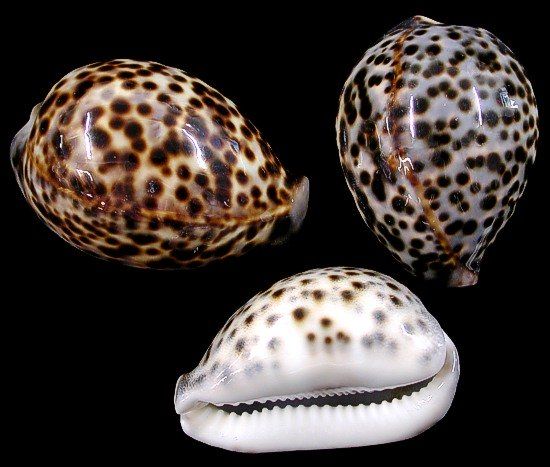One Tiger Cowrie shell measuring between 2 to 3 inches ****
One Tiger Cowrie shell, measuring between 2 to 3 inches.
Orders usually process within 2 to 5 business days.
Email us at ja1@mindspring.com Make Your Selections and Shipping Preference. We Will Email You the amount of the Shipping Cost. When you receive the shipping cost go back into Shells of Aquarius and click into Purchase Shipping Label. There you will find UPS or USPS. Click into the option you decided on and make your payment. Your order will ship when shipping payment is received.
Cypraea Tigris, common name Tiger Cowrie
These Cowries are egg-shaped and dextral, the glossy shell is large and heavy for a cowry. Tiger Cowries have been found to grow up to 6 inches, and the upper or dorsal side is white, pale bluish-white, or buff. They are densely covered with dark brown or blackish barely circular spots. The shells surface are notably effulgent, as if it were deliberately polished. There is sometimes a blurred red line along the length of the shell at the midline on the dorsal surface. The lower margins are rounded, there is no sharp margin between the upper and lower surfaces of the shell as is found in some other cowries. The ventral side is white or whitish, and the shell opening is lined with tooth-like serrations.(REF: Poutiers, J. M. (1998). "Gastropods". In Carpenter, K. E (ed) )
Tiger Cowries have two lateral extensions of the mantle are able to extend them to cover the shell completely, meeting at the midline of the dorsal surface. The mantle can also withdraw into the shell opening when threatened. The exterior surface of the mantle has numerous pin-like projections that are white-tipped.
The tiger cowrie is found on the ocean floor in the Indo-Pacific region, from the eastern coast of Africa to the waters of Micronesia and Polynesia, the Coral Sea and around the Philippines. Along the Australian Coast it is found from northern New South Wales to northern Western Australia, as well as Lord Howe Island, and along the east coast of Africa including Madagascar. This species are found between depths of 35 to 130 feet. They are often associated with live coral colonies, such as the table-forming Acropora, either found on the reefs themselves or the sandy sea bottom nearby. The Tiger Cowry were once common, but now much less abundant due to shell collecting and the destruction of its habitat by such processes as dynamite fishing, especially in shallower areas. The adults are carnivorous, feeding on coral and various invertebrates, while juveniles eat algae.(REF: Poutiers, J. M. (1998). "Gastropods". In Carpenter, K. E (ed.))
Some Japanese women believe holding the Cypraea tigris helps facilitate the childbirth process.
Scientific classification
Kingdom: Animalia
Phylum: Mollusca
Class: Gastropoda
(unranked): clade Caenogastropoda
clade Hypsogastropoda
clade Littorinimorpha
Super family: Cypraeoidea
Family: Cypraeidae
Subfamily: Cypraeinae
Genus: Cypraea
Species: C. tigris
Binomial name: Cypraea tigris
Linnaeus, 175
